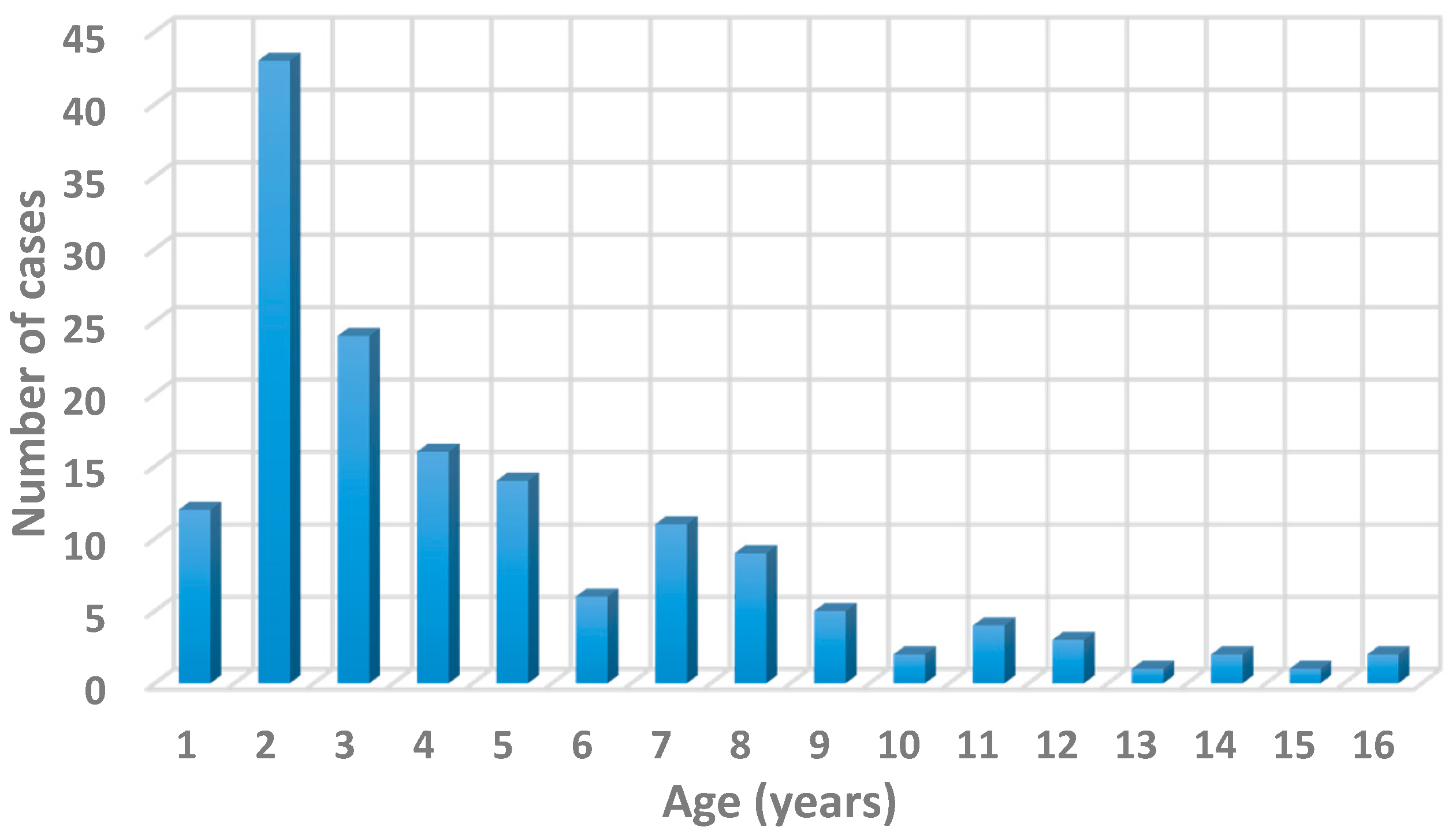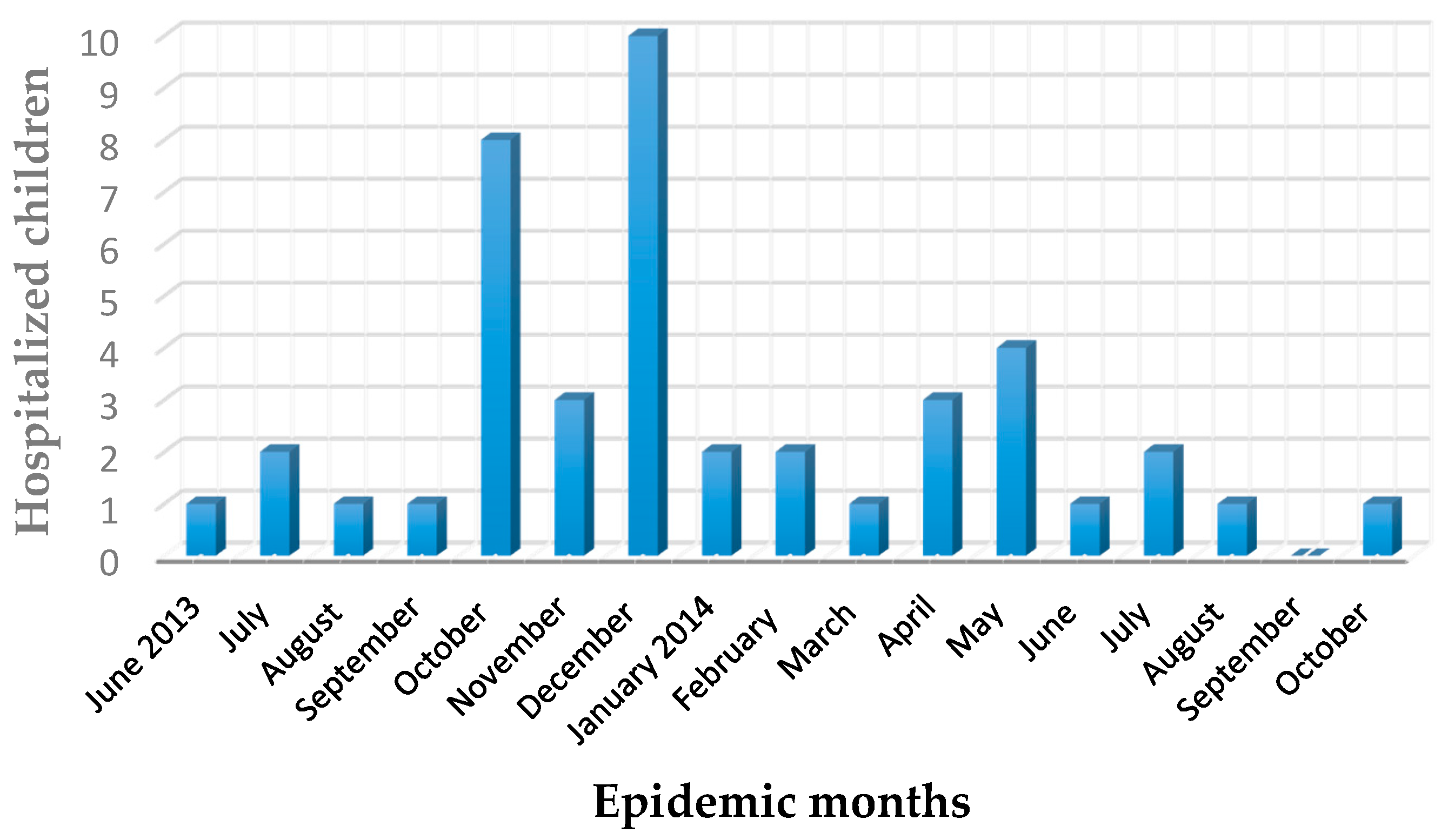Pediatric Epidemic of Salmonella enterica Serovar Typhimurium in the Area of L’Aquila, Italy, Four Years after a Catastrophic Earthquake
Abstract
:1. Introduction
2. Material and Methods
2.1. Patients
2.2. Survey on Food Products and Environmental Matrices
2.3. Microbiological Investigations
3. Results
3.1. Clinical Features
3.2. Epidemiological and Bacteriological Investigations
4. Discussion
5. Conclusions
Acknowledgments
Author Contributions
Conflicts of Interest
References
- Majowicz, S.E.; Musto, J.; Scallan, E.; Angulo, F.J.; Kirk, M.; O’Brien, S.J.; Jones, T.F.; Fazil, A.; Hoekstra, R.M.; International collaboration on enteric disease “burden of illness” studies. The global burden of nontyphoidal Salmonella gastroenteritis. Clin. Infect. Dis. 2010, 50, 882–889. [Google Scholar] [CrossRef] [PubMed]
- Wales, A.; Davies, R.H. Environmental aspects of Salmonella. In Salmonella in Domestic Animals, 2nd ed.; Barrow, P.A., Methner, U., Eds.; CAB International: Wallingford, UK, 2013; pp. 399–425. [Google Scholar]
- Rabsch, W.; Truepschuch, S.; Windhorst, D.; Gerlach, R.G. Typing phages and prophages of Salmonella. In Salmonella, from Genome to Function; Porwollik, S., Ed.; Caister Academic Press: Norfolk, UK, 2011; pp. 25–48. [Google Scholar]
- Petrovska, L.; Mather, A.E.; AbuOun, M.; Branchu, P.; Harris, S.R.; Connor, T.; Hopkins, K.L.; Underwood, A.; Lettini, A.A.; Page, A.; et al. Microevolution of monophasic Salmonella Typhimurium during epidemic, United Kingdom, 2005–2010. Emerg. Infect. Dis. 2016, 22, 4. [Google Scholar] [CrossRef] [PubMed]
- Trüpschuch, S.; Laverde Gomez, J.A.; Ediberidze, I.; Flieger, A.; Rabsch, W. Characterisation of multidrug-resistant Salmonella Typhimurium 4,[5],12:i:-DT193 strains carrying a novel genomic island adjacent to the thrW tRNA locus. Int. J. Med. Microbiol. 2010, 300, 279–288. [Google Scholar] [CrossRef] [PubMed]
- Orsini, M.; Mangone, I.; DiPasquale, A.; Perticara, S.; Sacchini, L.; Cito, F.; Iannetti, S.; Marcacci, M.; Ancora, M.; Calistri, P.; et al. Draft genome sequences of 19 Salmonella enterica serovar Typhimurium [4,5:i:-] strains resistant to nalidixic acid from a long-term outbreak in Italy. Genome Announc. 2015, 3, 911–915. [Google Scholar]
- Graziani, C.; Mughini-Gras, L.; Owczarek, S.; Dionisi, A.M.; Luzzi, I.; Busani, L. Distribution of Salmonella enterica isolates from human cases in Italy, 1980 to 2011. Euro. Surveill 2013, 18, 20519. [Google Scholar] [CrossRef] [PubMed]
- Callaway, T.R.; Edrington, T.S.; Anderson, R.C.; Byrd, J.A.; Nisbet, D.J. Gastrointestinal microbial ecology and the safety of our food supply as related to Salmonella. J. Anim. Sci. 2008, 86, E163–E172. [Google Scholar] [CrossRef] [PubMed]
- Lim, Y.H.; Hirose, K.; Izumiya, H.; Arakawa, E.; Takahashi, H.; Terajima, J.; Itoh, K.; Tamura, K.; Kim, S.I.; Watanabe, H. Multiplex polymerase chain reaction assay forselective detection of Salmonella enterica serovar Typhimurium. Jpn. J. Infect. Dis. 2003, 56, 151–155. [Google Scholar] [PubMed]
- European Centre for Disease Prevention and Control. Laboratory Standard Operating Procedure for MLVA of Salmonella enterica Serotype Typhimurium; ECDC: Stockholm, Sweden, 2011. [Google Scholar]
- Cito, F.; Baldinelli, F.; Calistri, P.; Di Giannatale, E.; Scavia, G.; Orsini, M.; Iannetti, S.; Sacchini, L.; Mangone, I.; Candeloro, L.; et al. Outbreak of unusual Salmonella enterica serovar Typhimurium monophasic variant 1,4 [5],12:i:-, Italy, June 2013 to September 2014. Euro. Surveill 2016, 21. [Google Scholar] [CrossRef] [PubMed]
- Haeusle, G.M.; Curtis, N. Non-typhoidal Salmonella in children: Microbiology, epidemiology and treatment. Adv. Exp. Med. Biol. 2013, 764, 13–26. [Google Scholar]
- Feasey, N.A.; Dougan, G.; Kingsley, R.A.; Heyderman, R.S.; Gordon, M.A. Invasive non-typhoidal salmonella disease: An emerging and neglected tropical disease in Africa. Lancet 2012, 379, 2489–2499. [Google Scholar] [CrossRef]
- Hohmann, E.L. Nontyphoidal salmonellosis. Clin. Infect. Dis. 2001, 32, 263–269. [Google Scholar] [PubMed]
- Pezone, I.; LaPenna, M.R.; Flamini, S.; Nigro, G. Non-typhoidal Salmonella septic arthritis in an immunocompetent child with a pharyngeal streptococcal infection. Int. J. Infect. Dis. 2009, 13, 35–36. [Google Scholar] [CrossRef] [PubMed]
- Gordon, M.A.; Graham, S.M.; Walsh, A.L.; Wilson, L.; Phiri, A.; Molyneux, E.; Zijlstra, E.E.; Heyderman, R.S.; Hart, C.A.; Molyneux, M.E. Epidemics of invasive Salmonella enterica serovar Enteritidis and S. enterica serovar Typhimurium infection associated with multidrug resistance among adults and children in Malawi. Clin. Infect. Dis. 2008, 46, 963–969. [Google Scholar] [CrossRef] [PubMed]
- Greene, S.K.; Daly, E.R.; Talbot, E.A.; Demma, L.J.; Holzbauer, S.; Patel, N.J.; Hill, T.A.; Walderhaug, M.O.; Hoekstra, R.M.; Lynch, M.F.; et al. Recurrent multistate outbreak of Salmonella Newport associated with tomatoes from contaminated fields, 2005. Epidemiol. Infect. 2008, 136, 157–165. [Google Scholar] [CrossRef] [PubMed]
- US FDA and California Food Emergency Response Team. Investigation of the Taco John’s Escherichia coli O157:H7 Outbreak Associated with Iceberg Lettuce. 2008. Available online: http://www.cdph.ca.gov/pubsforms/Documents/fdb%20eru%20IceLet%20TacoJohn022008.pdf (accessed on 29 April 2016). [Google Scholar]
- Centers for Disease Control and Prevention. Outbreak of Salmonella serotype Saintpaul infections associated with multiple raw produce items—United States, 2008. Morb. Mortal. Wkly. Rep. 2008, 57, 929–934. [Google Scholar]
- Fujimoto, T.; Tsuchiya, Y.; Shibuya, N.; Taiyoji, M.; Nishiwaki, T.; Nakamura, K.; Yamamoto, M. Contamination of the Shinano river water with mutagenic substances after the Niigata Chuetsu earthquake. Tohoku J. Exp. Med. 2007, 211, 171–180. [Google Scholar] [CrossRef] [PubMed]


| Clinical Findings | Hospitalized Patients (44) | Outpatients (111) | ||
|---|---|---|---|---|
| No. | % | No. | % | |
| Diarrhea | 44 | 100 | 111 | 100 |
| Bloody diarrhea | 25 | 57 | 5 | 4.5 |
| Fever | 44 | 100 | 22 | 19.8 |
| Dehydration | 42 | 100 | 0 | 0 |
| Electrolyte imbalance | 16 | 36 | 0 | 0 |
| Vomiting | 28 | 64 | 7 | 6.3 |
| Hip joint arthritis | 1 | 2 | 0 | 0 |
| Hospital stay (days) | 4.1 | _ | ||
| Laboratory Findings | Range | Mean Values | |
|---|---|---|---|
| Min | Max | ||
| Red blood cells (x mm3) | 3.39 | 5.62 | 4.89 |
| Hemoglobin (g/dL) | 11.1 | 15.2 | 13.0 |
| White blood cells (x mm3) | 5.3 | 22.3 | 10.1 |
| Neutrophils (%) | 24.7 | 90.4 | 64.8 |
| Lymphocytes (%) | 7.8 | 58.4 | 23.6 |
| Unclassified lymphocytes (%) | 0.6 | 9.9 | 3.7 |
| Platelets (x mm3) | 213 | 836 | 330 |
| Sodium (mEq/L) | 126 | 142 | 133 |
| Potassium (mEq/L) | 3.4 | 5.1 | 4.0 |
© 2016 by the authors; licensee MDPI, Basel, Switzerland. This article is an open access article distributed under the terms and conditions of the Creative Commons Attribution (CC-BY) license (http://creativecommons.org/licenses/by/4.0/).
Share and Cite
Nigro, G.; Bottone, G.; Maiorani, D.; Trombatore, F.; Falasca, S.; Bruno, G. Pediatric Epidemic of Salmonella enterica Serovar Typhimurium in the Area of L’Aquila, Italy, Four Years after a Catastrophic Earthquake. Int. J. Environ. Res. Public Health 2016, 13, 475. https://doi.org/10.3390/ijerph13050475
Nigro G, Bottone G, Maiorani D, Trombatore F, Falasca S, Bruno G. Pediatric Epidemic of Salmonella enterica Serovar Typhimurium in the Area of L’Aquila, Italy, Four Years after a Catastrophic Earthquake. International Journal of Environmental Research and Public Health. 2016; 13(5):475. https://doi.org/10.3390/ijerph13050475
Chicago/Turabian StyleNigro, Giovanni, Gabriella Bottone, Daniela Maiorani, Fabiana Trombatore, Silvana Falasca, and Gianfranco Bruno. 2016. "Pediatric Epidemic of Salmonella enterica Serovar Typhimurium in the Area of L’Aquila, Italy, Four Years after a Catastrophic Earthquake" International Journal of Environmental Research and Public Health 13, no. 5: 475. https://doi.org/10.3390/ijerph13050475
APA StyleNigro, G., Bottone, G., Maiorani, D., Trombatore, F., Falasca, S., & Bruno, G. (2016). Pediatric Epidemic of Salmonella enterica Serovar Typhimurium in the Area of L’Aquila, Italy, Four Years after a Catastrophic Earthquake. International Journal of Environmental Research and Public Health, 13(5), 475. https://doi.org/10.3390/ijerph13050475






